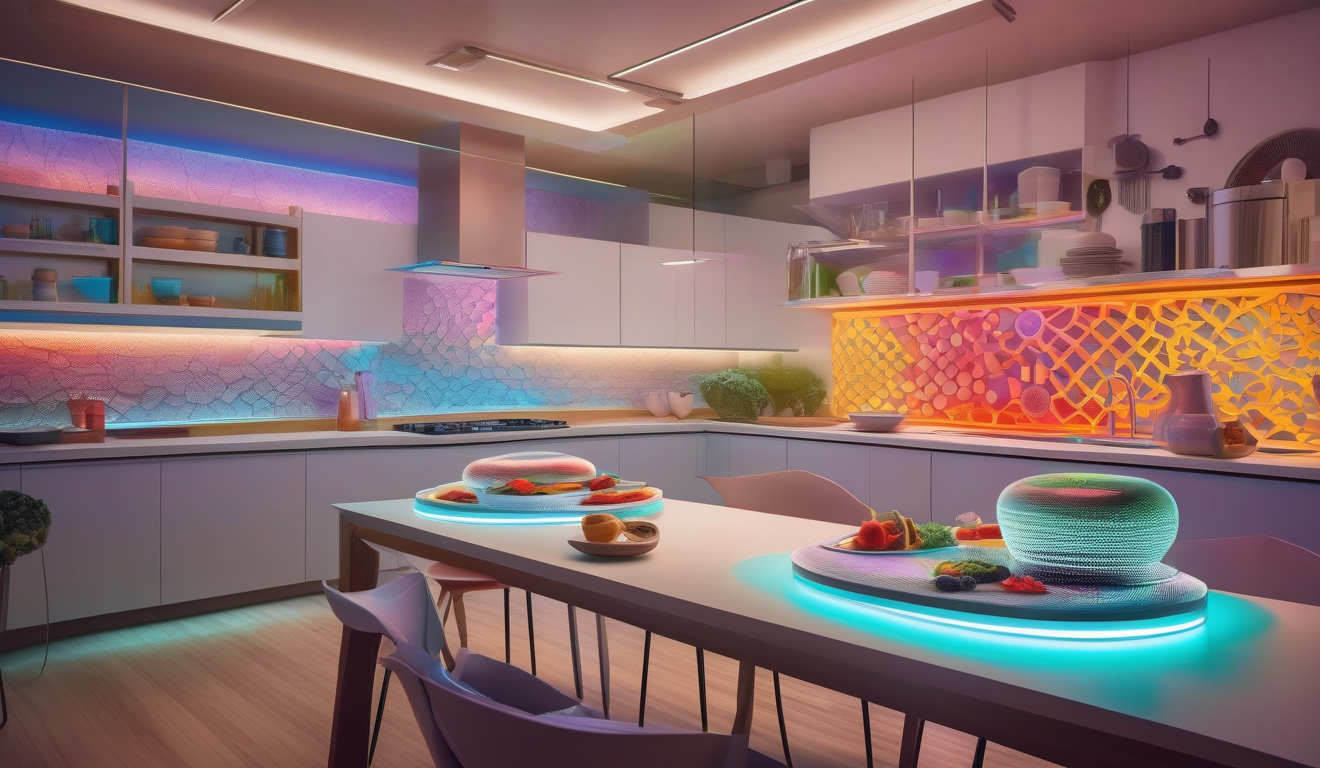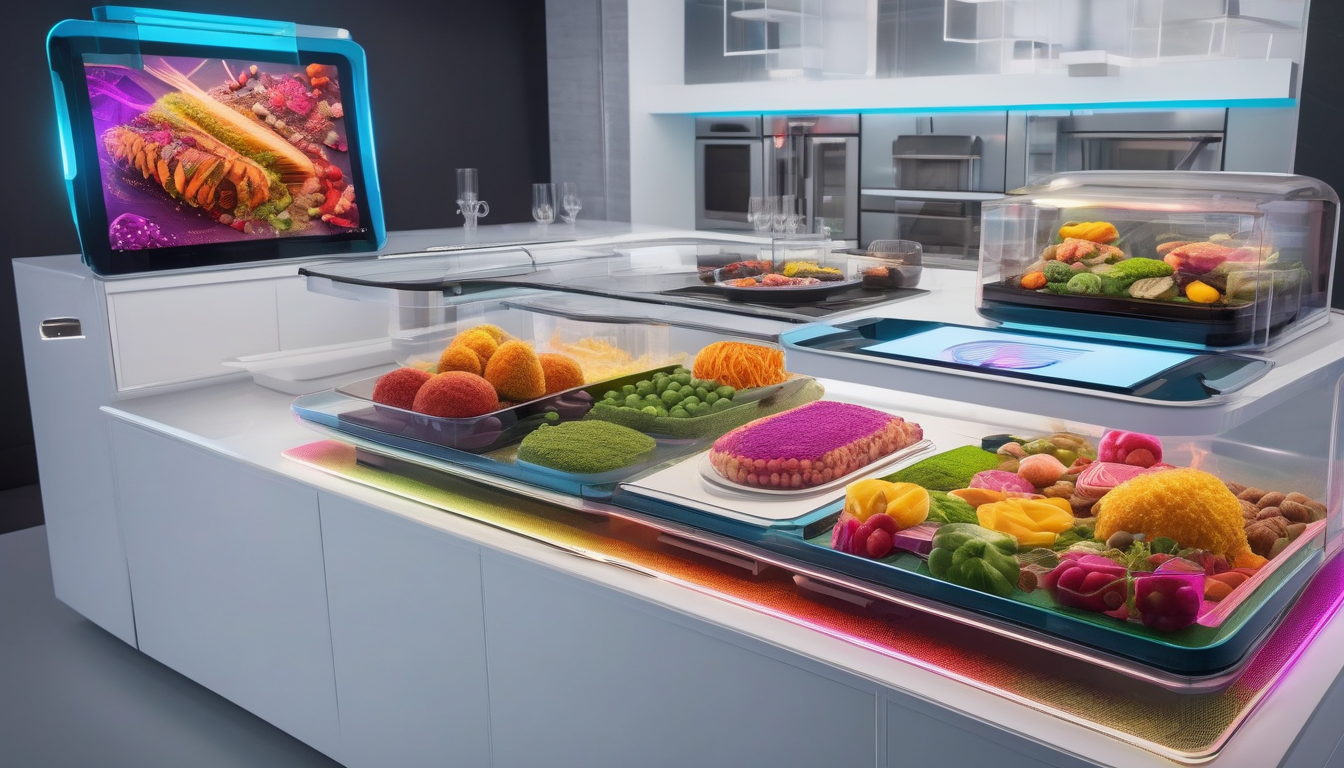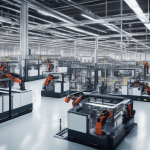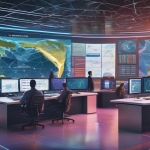The Impact of 3D-Printed Food on the Future of Dining

Imagine sitting down to a meal that was created just for you, tailored to your tastes and nutritional needs, all thanks to 3D printing technology. This isn’t science fiction; it’s the future of dining! As 3D-printed food becomes more prevalent, it is set to revolutionize how we think about meals, sustainability, and accessibility. This innovative approach not only enhances the culinary experience but also addresses some of the pressing challenges faced by our food systems today.
At its core, 3D food printing combines technology and creativity, allowing chefs and home cooks alike to experiment with ingredients in ways we never thought possible. Picture a world where your dinner plate is a canvas, and you can print your food in intricate shapes and flavors. This technology is not just about aesthetics; it’s about creating meals that cater specifically to individual preferences and dietary restrictions.
One of the most exciting aspects of 3D-printed food is the potential for customization. Whether you’re vegan, gluten-free, or simply have a penchant for spicy flavors, 3D printing can accommodate your unique palate. Imagine being able to adjust the nutritional content of your meals with just a few clicks, ensuring that you’re not only satisfied but also nourished. This level of personalization is a game changer in the culinary world, as it promotes healthier eating habits while reducing food waste.
Moreover, the sustainability factor cannot be ignored. Traditional food production methods often lead to significant waste and resource depletion. In contrast, 3D printing allows for precise ingredient usage, minimizing leftovers and excess. As we face global challenges such as climate change and food insecurity, adopting sustainable practices through technologies like 3D food printing could be our ticket to a more resilient food system.
As we look to the future, it’s clear that 3D-printed food will play a pivotal role in how we dine. From restaurants adopting this technology to home kitchens embracing the convenience and creativity it offers, the possibilities are endless. So, are you ready to take a bite out of the future? With 3D-printed food, the dining experience is about to get a whole lot more exciting!

The Technology Behind 3D-Printed Food
The world of culinary innovation is undergoing a remarkable transformation, and at the heart of this revolution lies 3D printing technology. Imagine a machine that can create delicious meals layer by layer, using a variety of ingredients tailored to your taste. This technology not only enhances creativity in the kitchen but also opens up new possibilities for how we think about food. At its core, 3D food printing utilizes a process similar to traditional 3D printing, where a digital design is translated into a physical object. However, in this case, the ‘object’ is not just a plastic toy but an edible masterpiece.
So, how does it work? The process begins with a digital model of the food item, created using specialized software. This model is then sliced into layers, which the 3D printer will replicate using various food materials. These materials can range from pureed fruits and vegetables to proteins and carbohydrates, allowing for a wide array of flavors and textures. The printer deposits these ingredients through a nozzle, building the dish layer by layer until it’s complete. This method not only ensures precision but also allows chefs to experiment with complex designs that would be nearly impossible to achieve through traditional cooking methods.
Moreover, the choice of materials is crucial in this process. Here are some common ingredients used in 3D food printing:
- Pureed fruits and vegetables
- Chocolate and sugar pastes
- Meat and fish pastes
- Flour-based doughs
Each of these materials can be enhanced with flavors, colors, and nutrients, creating a dish that is not only visually appealing but also packed with health benefits. This level of customization is a game-changer for the culinary world, allowing chefs to push the boundaries of traditional dining experiences.
As this technology continues to evolve, we can expect even more innovations in the types of ingredients used and the complexity of designs achievable. The future of food is being shaped by technology, and 3D printing is at the forefront of this exciting culinary adventure.

Benefits of 3D-Printed Food
3D-printed food is not just a futuristic concept; it’s a culinary revolution that brings a plethora of benefits to the table. Imagine a world where your meals are not only delicious but also tailored to your specific needs and preferences. This technology is transforming the way we think about food, offering advantages that extend beyond mere convenience.
One of the most significant benefits of 3D-printed food is the remarkable customization it allows. With traditional cooking, you might have to compromise on taste or nutrition, but with 3D printing, you can create meals that are perfectly suited to your palate. Whether you prefer spicy, sweet, or savory, the printer can adjust flavors and textures to meet your desires. This customization is especially beneficial for individuals with dietary restrictions or allergies, ensuring that everyone can enjoy their meals without worry.
Additionally, 3D food printing plays a crucial role in reducing food waste. By using only the necessary ingredients and creating precisely the right portions, this technology minimizes leftovers and excess. In fact, a study showed that up to 30% of food is wasted in traditional kitchens. With 3D printing, that number could significantly decrease, leading to a more sustainable food system. The ability to create meals on demand means that ingredients are utilized efficiently, and less food ends up in landfills.
Moreover, the potential for creative culinary experiences is limitless. Chefs around the world are harnessing the power of 3D printing to craft visually stunning dishes that are as much a feast for the eyes as they are for the palate. Imagine a plate that looks like a piece of art, with intricate designs and unexpected flavors. This not only enhances the dining experience but also encourages diners to explore new tastes and combinations, making every meal an adventure.
In summary, the benefits of 3D-printed food are profound and far-reaching. From customization and reduced waste to innovative culinary artistry, this technology is reshaping our dining experiences in exciting ways. As we embrace this new frontier in food preparation, we can look forward to a future where meals are not just sustenance but a personal expression of taste and creativity.
Customization and Personalization
Imagine walking into a restaurant where the menu is not just a list of dishes but a canvas waiting for your unique touch. 3D-printed food is transforming this dream into reality by allowing diners to customize their meals like never before. With the help of advanced technology, chefs can create dishes tailored to individual preferences, dietary needs, and even aesthetic desires. This means that your plate can be as unique as your personality!
One of the most exciting aspects of 3D food printing is its ability to cater to specific tastes. Whether you’re craving something sweet, savory, or spicy, the technology can adapt to your desires. For instance, if you love a certain flavor but have dietary restrictions, 3D printing can modify the ingredients without compromising on taste. This level of personalization not only enhances the dining experience but also encourages healthier eating habits. You can choose ingredients that align with your health goals, making every meal a step towards a better you.
Furthermore, the customization doesn’t stop at flavor. The visual appeal of food plays a significant role in our dining experience, and with 3D printing, chefs can craft visually stunning dishes that are as delightful to look at as they are to eat. Imagine a dish where the pasta is shaped like your favorite animal or where the dessert resembles a vibrant flower. This creative approach not only excites the palate but also makes dining a memorable occasion. In fact, the presentation can often spark conversations, adding a social element to the meal.
In essence, the fusion of technology and culinary arts through 3D printing is paving the way for a revolution in customization. It empowers consumers to take control of their dining experiences, making food not just a necessity but a delightful adventure. As this technology becomes more accessible, we can expect a shift in how we view meals—no longer just sustenance, but an opportunity for creativity and expression.
Dietary Restrictions and Allergies
In today’s world, where dietary preferences and restrictions are as diverse as the people who hold them, 3D-printed food technology offers an exciting solution. Imagine being able to enjoy a meal that not only satisfies your taste buds but also adheres to your specific dietary needs. This is the promise of 3D food printing, which can be tailored to accommodate various restrictions and allergies, ensuring that everyone can indulge in delicious meals without fear.
For individuals with conditions such as gluten intolerance or nut allergies, dining out can often feel like navigating a minefield. However, with 3D food printing, chefs can create customized dishes that exclude harmful ingredients while still delivering on flavor and presentation. This technology allows for precise control over the ingredients, making it possible to craft meals that are both safe and enjoyable.
Consider this: a family gathering where one member is vegan, another is gluten-free, and yet another has a peanut allergy. Traditionally, accommodating such diverse dietary needs would require extensive planning and compromise. However, with 3D printing, each person can have their own personalized meal, all prepared using the same high-tech equipment. This not only enhances the dining experience but also fosters inclusivity.
Moreover, the ability to create meals that cater to specific health concerns doesn’t just stop at allergies. 3D printing can also be utilized to develop meals that are tailored for individuals with diabetes, heart conditions, or other health issues. By adjusting the ingredients and nutritional content, chefs can ensure that every dish is not only safe but also promotes better health.
As we look towards the future, the potential for 3D-printed food to revolutionize how we approach dietary restrictions is immense. With the right technology in place, the culinary world can become a more accessible and enjoyable space for everyone. Imagine walking into a restaurant and being able to order a dish that is crafted specifically for your dietary needs, all thanks to the magic of 3D printing. This is not just a dream; it is rapidly becoming a reality.
Creative Culinary Experiences
Imagine walking into a restaurant where the menu is a canvas, and the dishes are masterpieces crafted with the precision of a 3D printer. are being revolutionized by this technology, allowing chefs to push the boundaries of traditional cooking. With 3D printing, chefs can create intricate designs and shapes that were previously unimaginable, transforming the way we perceive food.
For instance, think about how a simple plate of pasta can be reimagined. Instead of the usual spaghetti or fettuccine, chefs can print pasta in unique shapes, such as flowers or geometric patterns, making the dining experience visually stunning. This not only tantalizes the taste buds but also captivates the eyes, turning every meal into an event. The ability to create customized textures and flavors means that each dish can be tailored to the preferences of the diner, making every visit a unique adventure.
Moreover, 3D printing allows for the incorporation of various ingredients in ways that enhance taste and nutrition. For example, a chef can print a dish that combines proteins, vegetables, and grains into a single, cohesive unit, ensuring that diners receive a balanced meal without compromising on flavor. This innovation is particularly exciting for those who are health-conscious or looking to explore new culinary horizons.
In addition to enhancing flavor and presentation, 3D food printing opens up a world of possibilities for themed dining experiences. Restaurants can craft seasonal menus that reflect holidays or events, using 3D-printed elements to bring their concepts to life. Imagine a Halloween dinner featuring spooky-shaped desserts or a Valentine’s Day feast with heart-shaped pasta. These creative touches not only make meals more enjoyable but also create lasting memories for diners.
As chefs embrace this technology, the potential for interactive dining experiences also emerges. Imagine being able to customize your dish right at the table, selecting ingredients and watching as your meal is printed before your eyes. This level of engagement not only makes dining more fun but also fosters a deeper connection between the diner and the food they consume.
In conclusion, the integration of 3D printing in the culinary world is not just a passing trend; it’s a game changer that opens up endless possibilities for creativity and innovation. As we continue to explore the capabilities of this technology, the future of dining promises to be both exciting and delicious.
Sustainability in Food Production
The culinary world is undergoing a transformative shift with the advent of 3D-printed food, and one of the most significant impacts is its potential for enhancing sustainability in food production. Traditional food production methods often lead to excessive waste and resource depletion, but 3D printing offers a more efficient alternative. Imagine a system where ingredients are used to their fullest potential, minimizing waste and maximizing flavor. This is not just a dream; it’s becoming a reality.
One of the key advantages of 3D food printing is its ability to create meals using precisely measured ingredients. By utilizing only what is necessary for each dish, food waste can be significantly reduced. In fact, studies suggest that 3D printing can cut food waste by up to 50% compared to conventional cooking methods. This is especially important in a world where food scarcity is a pressing issue. The technology allows for the repurposing of food scraps into new, delicious meals, thus contributing to a more sustainable food cycle.
Moreover, the materials used in 3D food printing can be sourced sustainably. For instance, plant-based ingredients are often favored, as they require fewer resources to produce than animal products. This shift not only supports environmental health but also promotes a diet that is more aligned with contemporary sustainability goals. Imagine a future where your meal is crafted from ingredients that are grown locally, drastically reducing the carbon footprint associated with transportation.
Additionally, 3D printing technology can allow for the creation of nutrient-dense foods tailored to individual dietary needs, further enhancing sustainability by ensuring that people receive the necessary nutrients without the excess. This customization can lead to better health outcomes and reduced reliance on processed foods, which often contribute to environmental degradation.
In summary, the integration of 3D printing in food production holds the promise of a more sustainable future. By reducing waste, utilizing sustainable materials, and promoting healthier eating habits, this innovative technology is poised to revolutionize how we think about food. As we embrace these changes, the culinary landscape will not only become more exciting but also more responsible. Are you ready to be part of this deliciously sustainable revolution?
The Future of Dining with 3D Printing
As we stand on the brink of a culinary revolution, 3D food printing is poised to transform the way we think about dining. Imagine walking into a restaurant where your meal is not only tailored to your taste but also created right before your eyes! This technology isn’t just a gimmick; it’s a game-changer that could redefine our relationship with food. With advancements in this field, we can expect a future where customization, sustainability, and creativity flourish on our plates.
One of the most exciting aspects of 3D-printed food is its potential to integrate seamlessly into the dining experience. Restaurants are already experimenting with this technology, offering dishes that are as visually stunning as they are delicious. For instance, chefs can use 3D printers to create intricate designs that would be impossible to achieve through traditional cooking methods. This not only enhances the aesthetic appeal of the food but also provides diners with a unique experience that they can’t find anywhere else.
Moreover, the impact of 3D printing extends beyond the restaurant scene. Picture this: families at home using 3D food printers to whip up meals that cater to their specific dietary needs. Whether it’s gluten-free pasta or a protein-packed snack, the possibilities are endless. This technology empowers home cooks to experiment, play with flavors, and even involve kids in the kitchen, making meal prep a fun and engaging activity.
In addition to personalization, the sustainability aspect cannot be overlooked. As food waste becomes a growing concern, 3D printing offers a solution by allowing precise control over ingredient quantities. This means less food is discarded, and more can be enjoyed. The ability to use alternative ingredients, which can be printed into delicious meals, also opens the door to more sustainable food sources.
As we look to the future, it’s clear that the integration of 3D printing in dining will not just remain a novelty but will become a staple of our culinary landscape. From high-end restaurants to everyday kitchens, the potential for innovation is vast. The question is not if we will see this technology become mainstream, but rather how quickly it will reshape our dining experiences. Are you ready to embrace the future of food?
Integration into Restaurants
The culinary world is experiencing a seismic shift with the integration of 3D printing technology into restaurants. Imagine walking into your favorite dining spot and seeing chefs not just cooking but printing your meal right before your eyes! This revolutionary approach is not just about novelty; it’s about enhancing the entire dining experience and catering to the evolving tastes of consumers.
Restaurants are rapidly adopting 3D food printing to stay ahead of the competition. By incorporating this technology, they can offer a unique twist on traditional dishes, attracting a new wave of tech-savvy diners. For instance, a restaurant could create intricate pasta shapes or custom desserts that are not only delicious but also visually stunning. This level of creativity allows chefs to push the boundaries of culinary art, transforming meals into edible masterpieces.
Moreover, the integration of 3D printing can streamline restaurant operations. With the ability to print ingredients on-demand, chefs can minimize preparation time and reduce food waste. Less waste means lower costs and a more sustainable approach to food production. By utilizing precise measurements, restaurants can ensure that every ingredient is used efficiently, contributing to a greener planet.
Another exciting aspect of this technology is its potential for personalization. Imagine a menu where diners can choose not just their main dish but also the exact flavor profiles and nutritional content tailored to their preferences. This level of customization is a game-changer, as it allows restaurants to cater to a diverse clientele, including those with specific dietary needs.
However, the journey toward widespread adoption of 3D printing in restaurants isn’t without its challenges. Initial costs for equipment and training staff can be significant. Yet, as the technology matures and becomes more accessible, we can expect to see a surge in its use across the culinary landscape. In the end, the question isn’t whether 3D printing will become a staple in restaurants, but rather, how soon will it transform our dining experiences into something truly extraordinary?
Home Cooking Revolution
The advent of 3D food printing is set to spark a culinary revolution right in our own kitchens. Imagine being able to create your favorite dishes with just a few clicks! With 3D food printers, the barriers to home cooking are being shattered, allowing families to engage in the cooking process like never before. This technology not only makes it easier to prepare meals but also adds an element of fun and creativity that traditional cooking methods often lack.
One of the most exciting aspects of 3D-printed food is its ability to cater to individual tastes and dietary needs. For instance, if someone in your family is vegan or has a gluten allergy, you can customize meals that meet their specific requirements. This means no more worrying about cross-contamination or finding suitable options at the grocery store. Instead, you can design meals that are both delicious and safe, making dining a more inclusive experience for everyone.
Moreover, the interactive nature of 3D food printing can transform mealtime into a family event. Children can get involved in the process, choosing colors and shapes for their food, which can make healthy eating more appealing. It’s like having a personal chef at home, where you can experiment with flavors and presentations, turning ordinary meals into extraordinary culinary creations.
Consider this: with a 3D food printer, the possibilities are virtually endless. You can create everything from intricate desserts to savory dishes, all tailored to your family’s preferences. The technology allows you to print with various edible materials, ranging from doughs to purees. This means you can whip up a meal that not only tastes good but looks stunning, making every dinner feel like a special occasion.
In addition to creativity and customization, 3D food printers can also contribute to reducing food waste. By using only the ingredients you need and printing exactly the amount required, families can minimize leftovers and ensure that food is consumed fresh. This not only promotes sustainability but also encourages a more mindful approach to eating.
As we embrace this , it’s clear that 3D food printing is more than just a trend; it’s a glimpse into the future of how we will prepare and enjoy our meals. So, are you ready to transform your kitchen into a hub of innovation and creativity?
Frequently Asked Questions
- What is 3D-printed food?
3D-printed food refers to edible items created using 3D printing technology, where ingredients are extruded layer by layer to form intricate shapes and designs. This innovative method allows for creativity and precision in food preparation.
- How does 3D printing enhance customization in meals?
With 3D printing, meals can be tailored to individual preferences and dietary needs. For instance, you can adjust flavors, textures, and nutritional content, making dining experiences more personal and enjoyable.
- Can 3D-printed food accommodate dietary restrictions?
Absolutely! One of the major benefits of 3D-printed food is its ability to cater to various dietary restrictions and allergies. This means that people with specific health concerns can enjoy safe and delicious meals without worry.
- What are the sustainability benefits of 3D-printed food?
3D printing can significantly reduce food waste by utilizing only the necessary ingredients and minimizing excess. Additionally, it promotes sustainable practices by optimizing resource consumption throughout the food production process.
- How are restaurants integrating 3D printing into their menus?
Many restaurants are adopting 3D printing technology to create unique dishes that attract diners seeking novel culinary experiences. This technology can streamline operations and introduce exciting new flavors and presentations.
- What does the future hold for home cooking with 3D food printers?
The future looks bright! Home 3D food printers will empower families to experiment with recipes, create customized meals, and make cooking a fun, interactive experience that brings everyone together.













